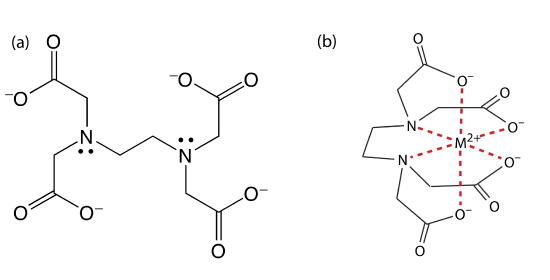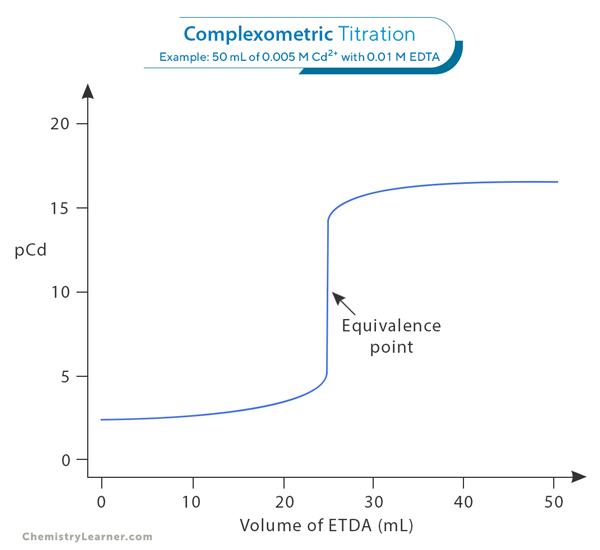Complexometric Titration
Complexometric titration is a technique in analytical chemistry that refers to forming stable complexes between metal ions and specific complexing agents. This technique is rooted in the principles of coordination chemistry, wherein ligands form strong, water-soluble complexes with metal ions. [1-4]
Complexometric Titration Reactions
Theoretically, any complexation reaction has the potential to serve as a volumetric technique given certain conditions: [3]
1. The reaction swiftly reaches equilibrium after adding each portion of the titrant.
2. No interfering circumstances emerge, such as the successive development of various metal ion complexes with the titrant, leading to the coexistence of multiple complexes in the solution during the titration.
3. A complexometric indicator that can reasonably pinpoint the equivalence point is at hand.
In reality, using EDTA as a titrant is firmly established.
Image Courtesy: Chem.libretexts.org
EDTA Complexometric Titration
EDTA, known as ethylenediaminetetraacetic acid, is the preferred choice in these titrations. It contains four carboxyl groups and two amine groups that function as electron pair donors, acting as Lewis bases. The capacity of EDTA to potentially contribute its six lone pairs of electrons for coordinating covalent bonds to metal cations classifies it as a hexadentate ligand. However, practically, EDTA is only partially ionized, leading to the formation of fewer than six coordinating covalent bonds with metal cations. [3]
Disodium EDTA is frequently utilized to calibrate aqueous solutions containing transition metal cations. Notably, disodium EDTA (sometimes denoted as Na2H2Y) establishes only four coordinating covalent bonds to metal cations at pH levels ≤ 12. Within this pH range, the amine groups remain protonated, impeding their ability to donate electrons for coordinating covalent bonds. The abbreviation Na4-xHxY represents any EDTA species, where x represents the count of acidic protons bonded to the EDTA molecule.
EDTA typically forms an octahedral complex with most 2+ metal cations, denoted as M2+, in aqueous solutions. One of the primary reasons for the extensive use of EDTA in calibrating metal cation solutions is the high formation constant of most metal cation-EDTA complexes. It implies that the equilibrium for the reaction:
M2+ + H4Y → MH2Y + 2 H+
significantly favors the formation of the EDTA-metal cation complex. Conducting the reaction in a basic buffer solution aids in removing H+ as it is generated, further promoting the production of the EDTA-metal cation complex reaction product. In practical terms, it is generally assumed that the formation of the metal cation-EDTA complex reaches completion.
The image below shows the titration curve for 50 mL of 5.00 × 10–3 M Cd2+ using a titrant of 0.01 M EDTA. The titrand is assumed to be buffered to a pH of 10 with a buffer of 0.01 M in NH3.
Indicators
Indicators serve as essential tools to signal the endpoint of the titration process when the formation of metal-ligand complexes is complete. Unlike acid-base titrations, where indicators showcase pH changes, indicators in complexometric titrations respond to changes in the metal-ligand complex’s color or properties. Various indicators are used in complexometric titrations, including metallochromic indicators and ion-selective electrodes. [3]
Method
Two primary methods are employed in complexometric titration to detect the endpoint: [4]
1. Visual Method
This method, commonly used for its accuracy and cost-effectiveness, includes several approaches for determining the end point of complexometric titrations. Examples encompass metallochromic or pM indicators, pH indicators, and redox indicators.
2. Instrumental Method
Instrumental techniques are employed to mitigate potential human error and enhance accuracy in endpoint determination. These methods encompass photometry, potentiometry, and various miscellaneous techniques.
Applications
Complexometric titration holds immense importance across diverse fields within analytical chemistry. Its adaptability allows for determining numerous metal ions in a solution, ranging from essential nutrients like calcium and magnesium in biological samples to heavy metals in environmental samples. Its selectivity towards specific metal ions and its ability to tolerate interference from other substances amplify its utility. Complexometric titration also plays a pivotal role in quality control processes across pharmaceuticals, food, and beverage industries, and environmental monitoring, ensuring compliance with stringent regulatory standards and maintaining product integrity. [5]

